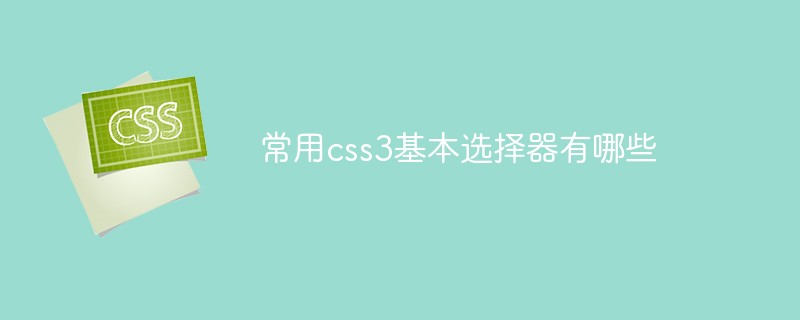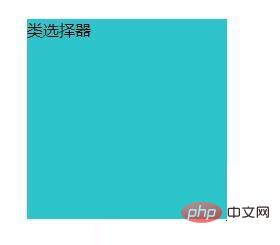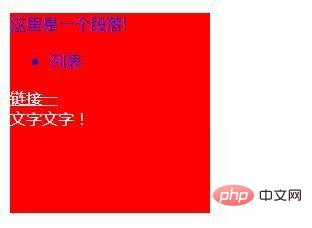What are the commonly used CSS3 basic selectors?
Commonly used CSS3 basic selectors include: 1. Wildcard selector "*"; 2. Class selector ".class name"; 3. Element selector; 4. ID selector "#id name" ; 5. The group selector "E, F,..." can group elements with the same style together. Use a comma "," to separate each selector.

The operating environment of this tutorial: Windows 7 system, CSS3&&HTML5 version, Dell G3 computer.
5 common basic selectors in css3
1. Wildcard selector (supported by all browsers)
The general selector is represented by *, which is used to select all elements, or all elements under a certain element;
*{marigin: 0;
padding: 0;
font-size: 14px;
}You must have seen the above code in the reset style file a lot, and what it represents Yes, the margin and padding of all elements are set to 0, and the font size is set to 14px. The other way is to select all elements under a certain element:
<!DOCTYPE html>
<html>
<head>
<meta charset="UTF-8">
<title>通配符选择器</title>
<style>
.demo * {
width: 50px;
height: 50px;
border: 1px solid blue;
margin: 10px;
}
</style>
</head>
<body>
<div class="demo">
<div>1</div>
<p>2</p>
<span>3</span>
</div>
</body>
</html>Rendering:

We can see that the three sub-elements div, p, and span in the demo element do not have CSS styles set respectively, but as long as we set a unified style for all elements under the demo element, then Styles will appear on the three sub-elements div, p, and span in the demo element.
2. Class selector (All browsers support class selectors, but multi-class selectors (.className1.className2) are not supported by ie6.)
The class selector selects based on the class name, preceded by ".", which specifies the style in a way that is independent of the document element. Before using the class selector, you need to define the class name on the html element. In other words, you need to ensure that the class The name exists in the html tag.
<!DOCTYPE html>
<html>
<head>
<meta charset="UTF-8">
<title>类选择器</title>
<style>
.demo {
width: 200px;
height: 200px;
margin: 50px auto;
background: #2DC4CB;
}
</style>
</head>
<body>
<div class="demo">类选择器</div>
</body>
</html>Rendering:

3. Element selector (supported by all browsers)
Element selection (tag name selector) is the most common and basic selector among CSS3 selectors. The element selector is actually the element of the document, such as html, body, p, p, etc. In the following example, the span element is selected and the font color is set to red.
<!DOCTYPE html>
<html>
<head>
<meta charset="UTF-8">
<title>元素选择器</title>
<style>
.demo {
width: 200px;
height: 200px;
margin: 50px auto;
}
span {
color: red;
}
</style>
</head>
<body>
<div class="demo">
<p>这里使用<span>元素选择器</span>改变了样式</p>
</div>
</body>
</html>Rendering:

4.ID selector (all browsers support)
ID The selector is very similar to the class selector mentioned above. Before using the ID selector, you need to add the ID name to the html document so that the corresponding element can be found in the style selector. The difference is ID selection. The selector is the only value in a page. When using a class, we add a "." sign (.className) before the corresponding class name, and the id selector uses "#" before the name, such as (#demo).
<!DOCTYPE html>
<html>
<head>
<meta charset="UTF-8">
<title>ID选择器</title>
<style>
#demo {
width: 200px;
height: 200px;
margin: 50px auto;
background: #FF0000;
}
</style>
</head>
<body>
<div id="demo">ID选择器</div>
</body>
</html>Rendering:

There are several places where the ID selector needs special attention:
First: one id in a document The selector is only allowed to be used once, because the id is unique in the page;
Second, id selectors cannot be combined and used like class selectors, and an element can only be named with one id name;
Third, you can use the same id name in different documents. For example, you can define "#important" for h1 in "test.html", or you can define p for "test1.html". The id is "#important", but the premise is that only one id called "#important" is allowed in test.html or test1.html.
5. Group selector (supported by all browsers)
When several elements have the same style attributes, they can call a statement together, and use Comma separated. Group selectors group elements with the same style together. Each selector is separated by a comma ",". This comma tells the browser that the rule contains multiple different selectors. If there is no comma, , then the meaning expressed is completely different. Omitting the comma becomes the descendant selector we mentioned earlier. You must be careful about this when using it.
<!DOCTYPE html>
<html>
<head>
<meta charset="UTF-8">
<title>群组选择器</title>
<style>
.demo {
width: 200px;
height: 200px;
margin: 50px auto;
background: #FF0000;
}
p,
li {
color: blue;
}
.demo1,
.demo2 {
color: #fff;
}
</style>
</head>
<body>
<div class="demo">
<p>这里是一个段落!</p>
<ul>
<li>列表</li>
</ul>
<a href="#" class="demo1">链接一</a><br>
<span class="demo2">文字文字!</span>
</div>
</body>
</html>Rendering:

(Learning video sharing: css video tutorial)
The above is the detailed content of What are the commonly used CSS3 basic selectors?. For more information, please follow other related articles on the PHP Chinese website!

Hot AI Tools

Undresser.AI Undress
AI-powered app for creating realistic nude photos

AI Clothes Remover
Online AI tool for removing clothes from photos.

Undress AI Tool
Undress images for free

Clothoff.io
AI clothes remover

Video Face Swap
Swap faces in any video effortlessly with our completely free AI face swap tool!

Hot Article

Hot Tools

Notepad++7.3.1
Easy-to-use and free code editor

SublimeText3 Chinese version
Chinese version, very easy to use

Zend Studio 13.0.1
Powerful PHP integrated development environment

Dreamweaver CS6
Visual web development tools

SublimeText3 Mac version
God-level code editing software (SublimeText3)

Hot Topics
 How to use bootstrap in vue
Apr 07, 2025 pm 11:33 PM
How to use bootstrap in vue
Apr 07, 2025 pm 11:33 PM
Using Bootstrap in Vue.js is divided into five steps: Install Bootstrap. Import Bootstrap in main.js. Use the Bootstrap component directly in the template. Optional: Custom style. Optional: Use plug-ins.
 The Roles of HTML, CSS, and JavaScript: Core Responsibilities
Apr 08, 2025 pm 07:05 PM
The Roles of HTML, CSS, and JavaScript: Core Responsibilities
Apr 08, 2025 pm 07:05 PM
HTML defines the web structure, CSS is responsible for style and layout, and JavaScript gives dynamic interaction. The three perform their duties in web development and jointly build a colorful website.
 Understanding HTML, CSS, and JavaScript: A Beginner's Guide
Apr 12, 2025 am 12:02 AM
Understanding HTML, CSS, and JavaScript: A Beginner's Guide
Apr 12, 2025 am 12:02 AM
WebdevelopmentreliesonHTML,CSS,andJavaScript:1)HTMLstructurescontent,2)CSSstylesit,and3)JavaScriptaddsinteractivity,formingthebasisofmodernwebexperiences.
 How to write split lines on bootstrap
Apr 07, 2025 pm 03:12 PM
How to write split lines on bootstrap
Apr 07, 2025 pm 03:12 PM
There are two ways to create a Bootstrap split line: using the tag, which creates a horizontal split line. Use the CSS border property to create custom style split lines.
 How to set up the framework for bootstrap
Apr 07, 2025 pm 03:27 PM
How to set up the framework for bootstrap
Apr 07, 2025 pm 03:27 PM
To set up the Bootstrap framework, you need to follow these steps: 1. Reference the Bootstrap file via CDN; 2. Download and host the file on your own server; 3. Include the Bootstrap file in HTML; 4. Compile Sass/Less as needed; 5. Import a custom file (optional). Once setup is complete, you can use Bootstrap's grid systems, components, and styles to create responsive websites and applications.
 How to insert pictures on bootstrap
Apr 07, 2025 pm 03:30 PM
How to insert pictures on bootstrap
Apr 07, 2025 pm 03:30 PM
There are several ways to insert images in Bootstrap: insert images directly, using the HTML img tag. With the Bootstrap image component, you can provide responsive images and more styles. Set the image size, use the img-fluid class to make the image adaptable. Set the border, using the img-bordered class. Set the rounded corners and use the img-rounded class. Set the shadow, use the shadow class. Resize and position the image, using CSS style. Using the background image, use the background-image CSS property.
 How to use bootstrap button
Apr 07, 2025 pm 03:09 PM
How to use bootstrap button
Apr 07, 2025 pm 03:09 PM
How to use the Bootstrap button? Introduce Bootstrap CSS to create button elements and add Bootstrap button class to add button text
 How to resize bootstrap
Apr 07, 2025 pm 03:18 PM
How to resize bootstrap
Apr 07, 2025 pm 03:18 PM
To adjust the size of elements in Bootstrap, you can use the dimension class, which includes: adjusting width: .col-, .w-, .mw-adjust height: .h-, .min-h-, .max-h-






